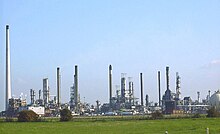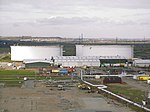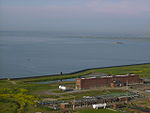Shell Haven
Shell Haven was a port on the north bank of the Thames estuary in the eastern tip of Thurrock County , Essex, England and a former oil refinery . The refinery was closed in 1999 and, after the facilities were dismantled, sold to DP World , which received planning permission in May 2007 for the " London Gateway " project , a deep-water container port . The first part of this new terminal went into operation on November 6, 2013.
history
Shell Haven first appears in Samuel Pepy's diary on June 10, 1667.
Also called Shellhaven in the history books , the place was originally a narrow bay on the north bank of the Thames, about a mile west of Canvey Island . Here was the mouth of Shellhaven Creek , a watercourse that runs east and south of the village of Fobbing and once separated the Corringham Marsh from the Fobbing Marsh. Shell Haven House was to the east . Sources do not entirely agree when Shell Haven was first associated with the oil industry; the first edition of an early 19th century map issued by the Ordnance Survey shows an oil mill near Shell Haven Creek. Shell Haven was also the site of a large Shell Oil Company refinery for more than 80 years - but there is no evidence that the company derived its name from this location.
In the 1850s, a branch line of the London, Tilbury and Southend Railway (LT&SR) was built to a new port called Thames Haven (also called Thameshaven), which is immediately west of Shell Haven. The Shell Haven name would probably have disappeared if Thames Haven had flourished and if the Shell Oil Company had n't looked for a place to build their refinery.
In 1895, the Kynoch munitions company bought Borley Farm east of Shell Haven Creek to manufacture explosives there. The factory and a small settlement for the company's employees called Kynochtown opened in 1897. Kynoch also founded the Corringham Light Railway (CLR) and built a passenger train route from the factory to Corringham, Essex and a freight train route to the LT&SR in Thames Haven. The ammunition factory was closed in 1919. The site and the railroad operations were taken over by the coal traders Cory Brothers Ltd from Cardiff, who built a mineral oil depot here and renamed Kynochtown Coryton. The oil depot later became the Coryton Refinery , which was operated first by Mobil from 1950 and then by various other companies and which is still in operation today.
The actual story of Shell Oil in Shell Haven began in the form of the Asiatic Petroleum Company Ltd . This commercial agency was entered in the commercial register as a joint venture between the Dutch Royal Dutch Petroleum and the British Shell Transport and Trading Company before the Royal Dutch Shell was founded . The license issued in 1912 was for the "storage of a maximum of 80,000 tons of petroleum at the Shell Haven location in iron tank containers, the capacity of which is limited to 4,000 tons" . The refining business began in 1916 with the construction of a 40-acre fuel distillation facility for the British Admiralty . In 1919, the plant was converted to produce bitumen for road surfaces. In 1925 a plant for the production of lubricating oils was built and in 1937 the first highly viscous oils were produced.
Even before the outbreak of the Second World War, additional plants were put into operation, including a mixing plant for plant chemicals.
The refineries and tank terminals of Thames Haven, Shell Haven and Coryton became easy targets during the air raids on England and were particularly badly damaged in the Battle of Britain in September 1940 .
In 1946 a plant for the production of high-quality paraffin for candles, paper, etc. was commissioned. The refinery's expansion began in 1947 on 400 acres west of the original refinery. The board of directors of Shell Petroleum Co Ltd gave the go-ahead in 1948 for the construction of a large new refinery, which was primarily tailored to the processing of crude oils from Kuwait.
The facility included
- a crude oil distillation with a capacity of 6000 tons of Kuwaiti crude oil per day and the plant designation was CDU1 (Crude Oil Distillation Unit 1)
- a high vacuum distillation with a capacity of 3500 tons of long residue called HVU for CCF (high vacuum unit for cat cracker feed)
- a visbreaker with a capacity of 1200 tons of naphtha per day
- a Gasoline Doctor Treater for desulfurization
- three 17 bar steam boilers with a flow-through cooling system suitable for salt water
and went into operation in 1950
Further systems were then gradually added to extract high-quality hydrocarbons from the distillation residues. In 1956, for example, a platformer was put into operation, and in the same year a petrochemical plant for the production of aromatics , the chemical raw material for household detergents . A second crude oil distillation was commissioned in 1959 and a second platformer in 1967. A hydrodesulfurization plant was built in 1972 and a third reformer in 1977. In 1979 a hydrocracker was added to increase the proportion of light distillates. In 1981 a new bitumen plant finally started work.
With the provision of considerable financial resources, the 'Naphtha Minus' complex was built in 1992, which included isomerization , benzene recovery and a gas turbine for power generation. In addition, a new control room was built.
The plant had now reached a capacity of 4.6 million tons per year and extended over an area of eight km², which was accompanied by a length of the boundary fence of 27 kilometers. The refinery had its own power plant, fire department and other emergency facilities. There were also five loading bridges that were suitable for tankers up to 300,000 tons. Products were brought to consumers by road tankers, by ship and via the UK pipeline network.
From one day to the next, the refinery was shut down in 1999. A small team of skilled workers and engineers stayed on the site for a few years to coordinate and monitor the dismantling of the industrial plant. The Shell Haven refinery facilities were completely scrapped, with the exception of the bitumen facility and some storage tanks. The two hydrocrackers were transferred to the Godorf plant of the Rheinland Raffinerie in July 2004 , where they were added to an existing ensemble of four identical reactors and have been in operation again since 2005.
Todays use
The site was bought in 2006 by DP World , one of the world's largest port operators. The acquisition took place at the same time as the purchase of the renowned shipping company P&O . In May 2007 DP World received approval for the plan to build a large deep-water container port, known as the London Gateway , in Shell Haven . In addition to the new port, the planning also included the construction of one of the largest logistics centers in Europe with strategically important connections to London, the south-east of the country and the rest of the UK. In May 2008 the UK Department for Transport issued the Harbor Empowerment Order , a regulation for London Gateway that gave the new port an official and legal framework and elevated London Gateway to the rank of authority. DP World is now challenged to invest over £ 1.5 billion over the next 10 to 15 years in developing the new port.
As the last plant in the old Shell Haven refinery, the bitumen plant was decommissioned in 2010.
Individual evidence
- ^ Samuel Pepys' Diary . (June 1667). Accessed January 30, 2012
- ↑ LM Henderson, WB Ross, CM Ridgway: Tetraethyllead Susceptibilities of Gasoline Doctor Treatment vs. Caustic Washing , Ind. Eng. Chem., 1939, 31 (1), pp. 27-30; doi : 10.1021 / ie50349a005
Web links
- Thurrock council -Thurrock Heritage - Factfiles 49 - Corringham Light railway
- About Shell - The Shell history - the beginnings
- An account of the visit to the Shell Haven Oil Refinery 1990
- Institute of Petroleum Interactive Guide to UK Refineries - Shell Haven (Shell)
- London Gateway Planning Inquiry
- P&O London Gateway decision press release
Coordinates: 51 ° 30 ′ 47.2 " N , 0 ° 28 ′ 46" E











